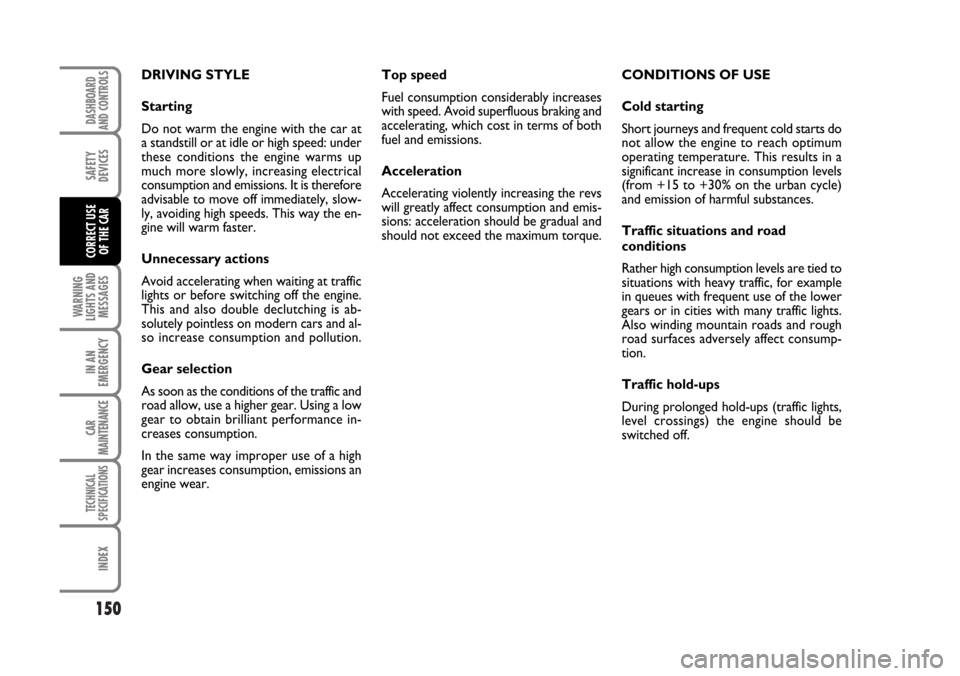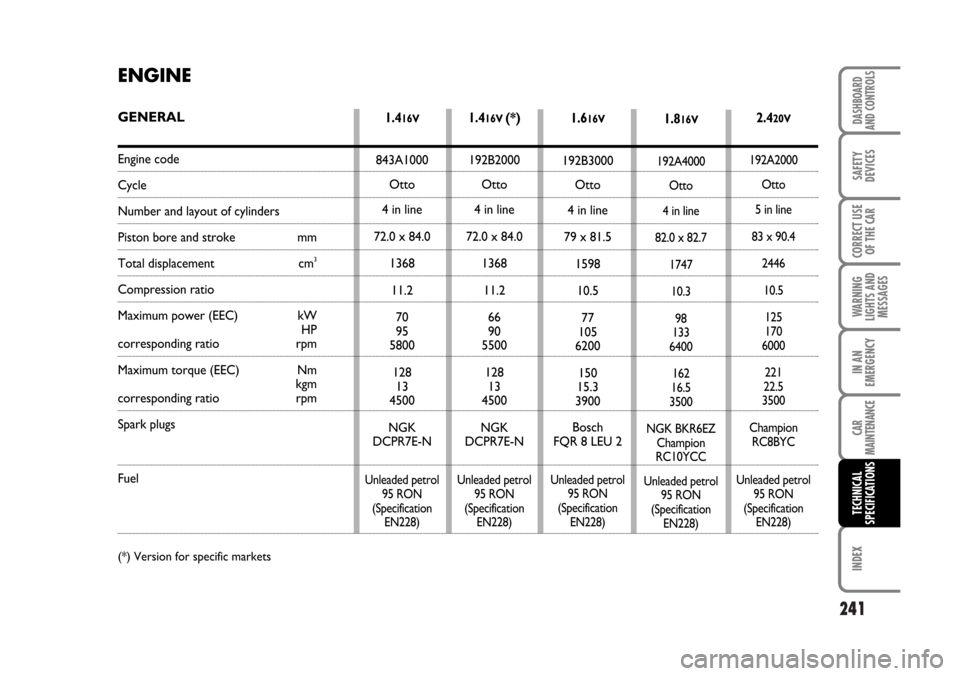torque FIAT STILO 2006 1.G Owners Manual
[x] Cancel search | Manufacturer: FIAT, Model Year: 2006, Model line: STILO, Model: FIAT STILO 2006 1.GPages: 274, PDF Size: 4.76 MB
Page 100 of 274

99
SAFETY
DEVICES
CORRECT USE
OF THE CAR
WARNING
LIGHTS AND
MESSAGES
IN AN
EMERGENCY
CAR
MAINTENANCE
TECHNICAL
SPECIFICATIONS
INDEX
DASHBOARD
AND CONTROLS
Failure indications
In the event of malfunctioning, the ASR
system is automatically disconnected and
the warning light
áwill come on with
fixed light on the instrument panel to-
gether with the message on the display
(see section “Warning lights and mes-
sages”). In this case contact Fiat Dealer-
ship as soon as possible. MSR system
(engine braking torque control)
The car is fitted with a special system, in-
tegral with the ASR system, that in case of
sudden gear shifting, cuts in providing
torque to the engine thus preventing ex-
cessive driving wheel drive that, specially
in poor grip conditions, can lead to loss of
stability.
EOBD SYSTEM
The EOBD system (European On Board
Diagnosis) allows continuous diagnosis of
the components of the car correlated with
emissions.
It also alerts the driver, by turning on the
warning light
Uon the instrument pan-
el (together with the message on the dis-
play) (see section “Warning lights and
messages”), when these components are
no longer in peak conditions.
The objective is:
❒to keep the system efficiency under
control;
❒warn when a fault causes emissions lev-
els to increase;
❒warn of the need to replace deterio-
rated components.
The system also has a diagnostic connec-
tor that can be interfaced with appropri-
ate tools, which makes it possible to read
the error codes stored in the control unit,
together with a series of specific parame-
ters for engine operation and diagnosis.
This check can also be carried out by the
traffic police.
When using the spare wheel,
the ASR system is excluded
and the warning light
áon the in-
strument panel turns on glowing
steadily together with the message on
the display (see section “Warning
lights and messages”).
WARNING
For correct operation of the
ASR system, the tyres must
absolutely be of the same brand and
type on all wheels, in perfect condi-
tions and, above all, of type, brand
and size specified.
WARNING
Page 145 of 274

144
WARNING
LIGHTS AND
MESSAGES
IN AN
EMERGENCY
CAR
MAINTENANCE
TECHNICAL
SPECIFICATIONS
INDEX
DASHBOARD
AND CONTROLS
SAFETY
DEVICES
CORRECT USE
OF THE CAR
IMPORTANT NOTES
❒With the car stopped and a gear en-
gaged always keep the brake pedal
pressed until deciding to move off;
❒during prolonged halts with the engine
running it is advisable to keep the gear-
box in neutral;
❒when the car is parked facing uphill, do
not use the moving off manoeuvre to
keep the car still; use the brake pedal
and press the accelerator pedal only
when the deciding to move off;
❒use second gear (2) only when more
control is needed for moving off ma-
noeuvres at low speed;
❒if, in reverse gear, first (1) gear is en-
gaged or vice versa, shift gear only
when the car is stopped completely and
with the brake pedal pressed.Though highly inadvisable, if when travel-
ling downhill for some unexpected reason
the car is set to neutral (N), when the en-
gagement of a gear is requested, the sys-
tem automatically engages the best gear in
relation to the speed of the car to allow
the correct transmission of torque to the
wheels.
When travelling downhill with a gear en-
gaged and the accelerator released (if the
car is moving), beyond a pre-established
speed, the system engages the clutch au-
tomatically to give the car adequate engine
braking.GEARSHIFTING
Through lever
Gearshifting takes place through the con-
trol lever A-fig. 8, which is of the float-
ing type with a “single central stable po-
sition”. It is possible to request an in-
crease/decrease of the gear ratio engaged
and/or reverse gear engagement (R) or
neutral (N).
To request gearshifting proceed as follows
fig. 9:
❒shift upwards (+) push the lever for-
wards. If the system is in neutral (N) or
in reverse (R) moving the lever for-
wards causes the engagement of first
gear (1);
❒to shift downwards (-) push the lever
backwards.
fig. 8F0C00105mfig. 9F0C0184m
Page 151 of 274

150
WARNING
LIGHTS AND
MESSAGES
IN AN
EMERGENCY
CAR
MAINTENANCE
TECHNICAL
SPECIFICATIONS
INDEX
DASHBOARD
AND CONTROLS
SAFETY
DEVICES
CORRECT USE
OF THE CAR
Top speed
Fuel consumption considerably increases
with speed. Avoid superfluous braking and
accelerating, which cost in terms of both
fuel and emissions.
Acceleration
Accelerating violently increasing the revs
will greatly affect consumption and emis-
sions: acceleration should be gradual and
should not exceed the maximum torque.CONDITIONS OF USE
Cold starting
Short journeys and frequent cold starts do
not allow the engine to reach optimum
operating temperature. This results in a
significant increase in consumption levels
(from +15 to +30% on the urban cycle)
and emission of harmful substances.
Traffic situations and road
conditions
Rather high consumption levels are tied to
situations with heavy traffic, for example
in queues with frequent use of the lower
gears or in cities with many traffic lights.
Also winding mountain roads and rough
road surfaces adversely affect consump-
tion.
Traffic hold-ups
During prolonged hold-ups (traffic lights,
level crossings) the engine should be
switched off. DRIVING STYLE
Starting
Do not warm the engine with the car at
a standstill or at idle or high speed: under
these conditions the engine warms up
much more slowly, increasing electrical
consumption and emissions. It is therefore
advisable to move off immediately, slow-
ly, avoiding high speeds. This way the en-
gine will warm faster.
Unnecessary actions
Avoid accelerating when waiting at traffic
lights or before switching off the engine.
This and also double declutching is ab-
solutely pointless on modern cars and al-
so increase consumption and pollution.
Gear selection
As soon as the conditions of the traffic and
road allow, use a higher gear. Using a low
gear to obtain brilliant performance in-
creases consumption.
In the same way improper use of a high
gear increases consumption, emissions an
engine wear.
Page 242 of 274

241
WARNING
LIGHTS AND
MESSAGES
INDEX
DASHBOARD
AND CONTROLS
SAFETY
DEVICES
CORRECT USE
OF THE CAR
IN AN
EMERGENCY
CAR
MAINTENANCE
TECHNICAL
SPECIFICATIONS
ENGINE
GENERAL
Engine code
Cycle
Number and layout of cylinders
Piston bore and stroke mm
Total displacement cm3
Compression ratio
Maximum power (EEC) kW
HP
corresponding ratio rpm
Maximum torque (EEC) Nm
kgm
corresponding ratio rpm
Spark plugs
Fuel
1.416V
843A1000
Otto
4 in line
72.0 x 84.0
1368
11.2
70
95
5800
128
13
4500
NGK
DCPR7E-N
Unleaded petrol
95 RON
(Specification
EN228)
1.416V (*)
192B2000
Otto
4 in line
72.0 x 84.0
1368
11.2
66
90
5500
128
13
4500
NGK
DCPR7E-N
Unleaded petrol
95 RON
(Specification
EN228)
1.616V
192B3000
Otto
4 in line
79 x 81.5
1598
10.5
77
105
6200
150
15.3
3900
Bosch
FQR 8 LEU 2
Unleaded petrol
95 RON
(Specification
EN228)
1.816V
192A4000
Otto
4 in line
82.0 x 82.7
1747
10.3
98
133
6400
162
16.5
3500
NGK BKR6EZ
Champion
RC10YCC
Unleaded petrol
95 RON
(Specification
EN228)
2.420V
192A2000
Otto
5 in line
83 x 90.4
2446
10.5
125
170
6000
221
22.5
3500
Champion
RC8BYC
Unleaded petrol
95 RON
(Specification
EN228)
(*) Version for specific markets
Page 243 of 274

242
WARNING
LIGHTS AND
MESSAGES
INDEX
DASHBOARD
AND CONTROLS
SAFETY
DEVICES
CORRECT USE
OF THE CAR
IN AN
EMERGENCY
CAR
MAINTENANCE
TECHNICAL
SPECIFICATIONS
(*) Version for specific markets
GENERAL
Engine code
Cycle
Number and layout of cylinders
Piston bore and stroke mm
Total displacement cm3
Compression ratio
Maximum power (EEC) kW
HP
corresponding ratio rpm
Maximum torque (EEC) Nm
kgm
corresponding ratio rpm
Fuel
1.9 Multijet 8V
192A8000
Diesel
4 in line
82.0 x 90.4
1910
18
88
120
4000
255
26
2000
Diesel fuel for
motor vehicles
(Specification EN590)
1.9 Multijet 16V
937A5000
Diesel
4 in line
82.0 x 90.4
1910
17.5
110
150
4000
305
31
2000
Diesel fuel for
motor vehicles
(Specification EN590)
1.9 Multijet 8V (*)
192B4000
Diesel
4 in line
82.0 x 90.4
1910
18
85
115
4000
255
26
2000
Diesel fuel for
motor vehicles
(Specification EN590)
1.9 Multijet 16V (*)
Diesel
4 in line
82.0 x 90.4
1910
17.5
100
136
4000
305
31
2000
Diesel fuel for
motor vehicles
(Specification EN590)